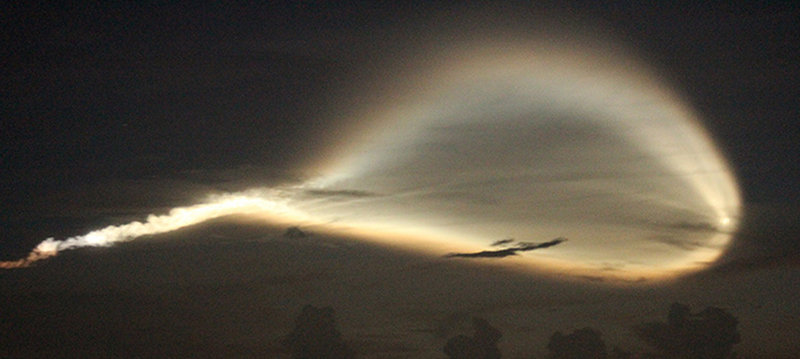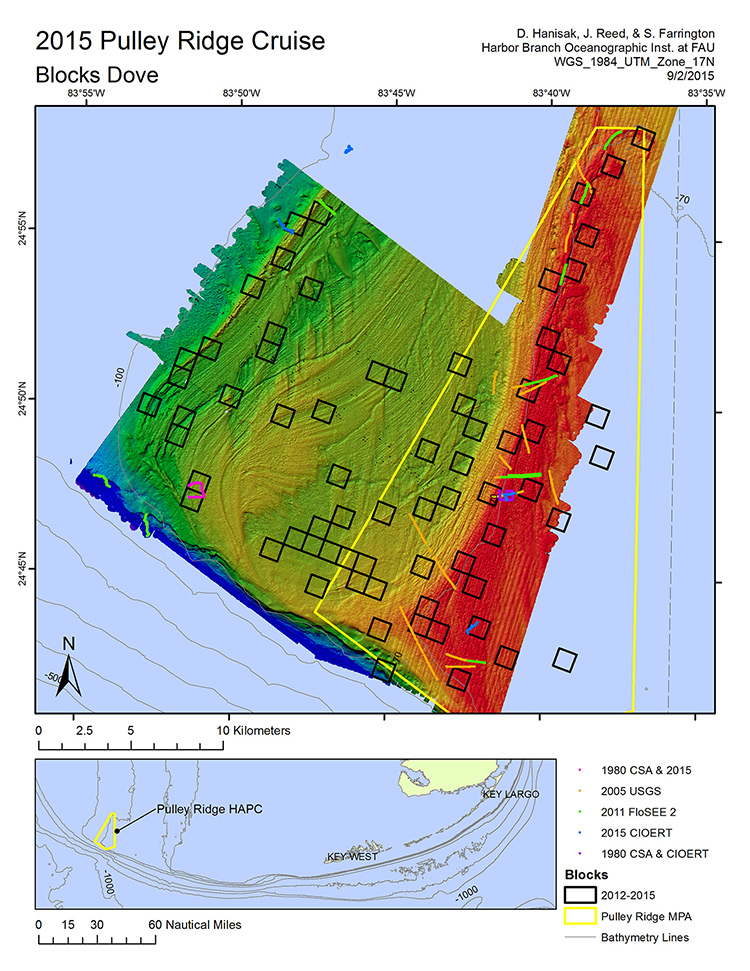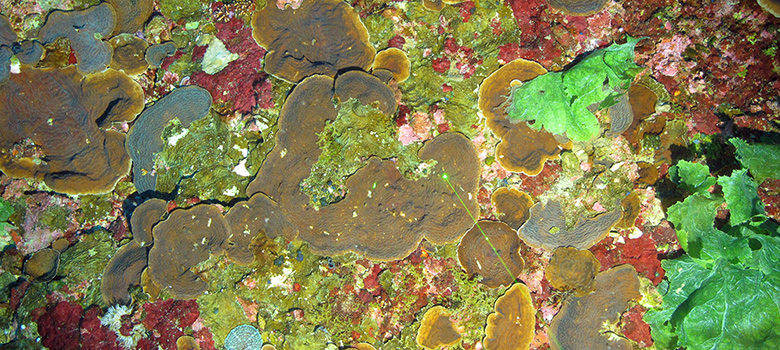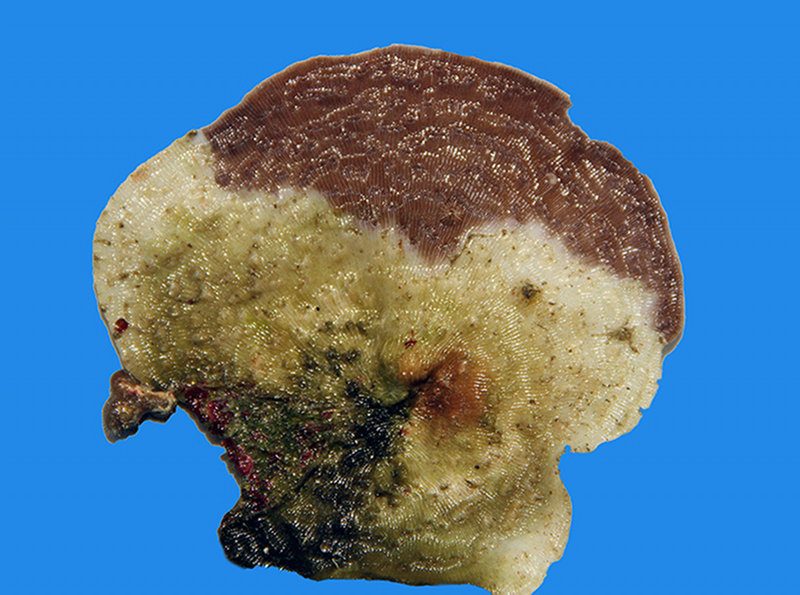
By M. Dennis Hanisak, Chief Scientist for the Coral Ecosystem Connectivity 2015 Cruise, and Research Professor - Florida Atlantic University - Harbor Branch
September 2, 2015
Our last day of operations on this cruise began auspiciously. The early risers in our science party were in the lab when Captain Shawn Lake broke the stillness with an announcement over the loudspeaker: “Look to the sky on the port side!”

Shortly before sunrise, we saw the Atlas V rocket launched from Cape Canaveral, over 300 miles away. The sunlight caught the rocket's plume trail at just the right angle, creating a colorful display. Image courtesy of Jason White, University of North Carolina at Wilmington’s Undersea Vehicles Program. Download larger version (jpg, 510 KB).
Three of us stumbled onto the deck to see an amazing light show in the sky. Initially, appearing more like a comet, it soon became clear that it must be a rocket launch. I was amazed we could see it so well as it launched from Cape Canaveral. We confirmed shortly afterward: an Atlas V rocket had been launched a few minutes earlier. Although we were over 300 miles away, the sunlight caught the rocket's plume trail at just the right angle, creating a colorful display.
Then as we were preparing for our first dive, a large billowy cloud formed to the northwest and it began to rain. A rainbow quickly formed. What could be better forerunners for our last day at Pulley Ridge than rockets and a rainbow?

Over four cruises, our Community Structure Team has crisscrossed Pulley Ridge in an effort to better assess its biological resources (corals, fish, sponges, algae). ROV surveys have been conducted in 69 one kilometer by one kilometer blocks. Image courtesy of Stephanie Farrington, FAU Harbor Branch. Download larger version (jpg, 947 KB).
Our first dive of the day did not turn out as well as we hoped. We had picked a site off the southern edge of Pulley Ridge, a wall, which was likely to have populations of larger fishery species. But the currents were strong and made maneuvering the remotely operated vehicle (ROV) and ship a challenge. We never made it to the wall, settling for transects in a rubble area with much less fish than we had hoped to see.
Enroute, I had a chance to reflect on our four Connectivity cruises and what we expected to find each year and what we actually saw.
In 2012, we expected to see much more coral based on previous reports of high coral abundance at Pulley Ridge. We were surprised and dismayed by the relatively low abundance and distribution of corals on the main ridge.
We explored more of the ridge and nearby sites in 2013, with those sites having even less coral than the ones surveyed the year before.
Thus, in 2014, we were astonished to discover a large amount of plate coral (Agaricia spp.)…more than anything we had seen in any of our Pulley Ridge cruises over the previous five years (John Reed, Stephanie Farrington, and I also cruised here in 2010 and 2011). Besides large numbers of small corals (10 centimeters or less), indicative of recent recruitment, we saw several large patches (up to 60 meters across) of nearly continuous Agaricia. These coral populations are quite significant at Pulley Ridge and a major finding of the 2014 cruise. I wistfully called this newly explored area “ Coral Valley?”

This cruise has shown that the large area of Agaricia discovered last year at Pulley Ridge is even larger than we thought. The site provides evidence of a very significant coral recruitment happening in recent years, a hopeful sign of resilience in this species. Image courtesy of Coral Ecosystem Connectivity 2015 Expedition. Download larger version (jpg, 1.3 MB).
Which brings us back to our last dive of this year’s cruise, located in “Coral Valley.” We had done several other dives during the cruise in the vicinity, but today we added three more surveys of one kilometer by one kilometer blocks. We were pleased to see large areas of Agaricia, again dominated by small coral recruits.
We wish we could do more, but time is up! We have many analyses to do back in the lab before we can accurately quantify what we have seen on all of these cruises, but our initial consensus is that we believe that our surveys will indicate that the distribution of coral on Pulley Ridge is more than twice what we thought it was at the start of the project. That is a very positive finding, certainly not what we thought would be the case after our 2012 and 2013 cruises. We believe the extensive area of small Agaricia coral is evidence of a very significant recruitment event or series of events that happened during the last five years, following what is still an unexplained decline in corals prior to our recent work at Pulley Ridge.

In addition to counting the numbers and measuring sizes of all corals in our photosamples, we will also quantify coral mortality and diseases. This coral inexplicably was half dead, with no clear sign of cause. Image courtesy of Brian Cousin, FAU Harbor Branch. Download larger version (jpg, 629 KB).
This new information suggests that these coral populations are resilient, able to rebound from a decline fairly quickly. That is good news not only for corals and related biological resources at Pulley Ridge, but also for other coral reef systems in Florida and the Caribbean. If local environmental stressors can be reduced or eliminated, there is reason to believe that the downward trajectory of coral reefs can be reversed elsewhere, too. If biologically and physically connected to other systems such as the Florida Keys, Pulley Ridge may be serve as a refuge and be able to contribute to the recovery of other coral reefs.
After four years, I think we have discovered a story unlike the one we first thought we would find and unlike the one that we initially thought we had found. That is the essence of research. In the words of Albert Einstein: “If we knew what it was we were doing, it would not be called research, would it?”
This would be a good time to thank the many scientists, technicians, and support staff who contributed to the success of these four cruises, and the many scientists involved with this large collaborative project. We especially thank the great work and services provided by Captain Shawn Lake and his crew on the R/V Walton Smith. They made these four voyages of discovery safe, productive, and fun!
So, like so many research projects, we have answered some questions, and leave behind new ones. For some of us, this is our last trip to Pulley Ridge; for others, we will be back!